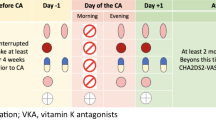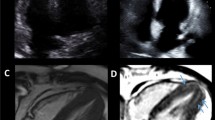Abstract
Background
Cardiac magnetic resonance (CMR) allowed to precisely identify the substrate in scar-related ventricular tachycardia (VT). New software has been developed to define the 3D scar and corridors to help VT ablation by integrating the scar and electroanatomical mapping (EAM). The objective of this study is to evaluate the results of VT ablation aided by the integration of EAM and CMR software processed scar.
Methods
We selected patients that underwent VT ablation with the integration of EAM and CMR processed using ADAS software and imported to the CARTO system using VTK file format.
Results
From 2019 to 2021, eight patients (mean age 63 ± 4.4, 62.5% male; EF 47 ± 12%) underwent CMR-aided VT ablation. Mean procedural time was 281 ± 77 min. There was of 9 ± 4.4 epicardial and 7.9 ± 4.3 endocardial bulls eye segments with at least 2 g of border zone or core scar. In a median follow-up time of 532 days (Q1: 284, Q3: 688), three patients (37.5%) presented VT recurrence, all three underwent a second procedure, with no VT recurrence on the follow-up. No patient died in the follow-up.
Conclusion
CMR aided is ablation is feasible and effective in patients with scar related VT.
Graphical Abstract





Similar content being viewed by others
Data availability
The datasets analyzed in this study are available from the corresponding author upon reasonable request.
References
Sapp JL, Wells GA, Parkash R, Stevenson WG, Blier L, Sarrazin JF, et al. Ventricular Tachycardia Ablation versus Escalation of Antiarrhythmic Drugs. N Engl J Med. 2016;375(2):111–21.
Cronin EM, Bogun FM, Maury P, Peichl P, Chen M, Namboodiri N, et al. 2019 HRS/EHRA/APHRS/LAHRS expert consensus statement on catheter ablation of ventricular arrhythmias: Executive summary. Heart Rhythm. 2020;17(1):e155–205.
Tung R, Vaseghi M, Frankel DS, Vergara P, Di Biase L, Nagashima K, et al. Freedom from recurrent ventricular tachycardia after catheter ablation is associated with improved survival in patients with structural heart disease: an International VT Ablation Center Collaborative Group study. Heart Rhythm. 2015;12(9):1997–2007.
Briceno DF, Gupta T, Romero J, Kolte D, Khera S, Villablanca PA, et al. Catheter ablation of ventricular tachycardia in nonischemic cardiomyopathy: a propensity score-matched analysis of in-hospital outcomes in the United States. J Cardiovasc Electrophysiol. 2018;29(5):771–9.
Andreu D, Penela D, Acosta J, Fernandez-Armenta J, Perea RJ, Soto-Iglesias D, et al. Cardiac magnetic resonance-aided scar dechanneling: Influence on acute and long-term outcomes. Heart Rhythm. 2017;14(8):1121–8.
Soto-Iglesias D, Penela D, Jauregui B, Acosta J, Fernandez-Armenta J, Linhart M, et al. Cardiac magnetic resonance-guided ventricular tachycardia substrate ablation. JACC Clin Electrophysiol. 2020;6(4):436–47.
Sosa E, Scanavacca M, d’Avila A, Pilleggi F. A new technique to perform epicardial mapping in the electrophysiology laboratory. J Cardiovasc Electrophysiol. 1996;7(6):531–6.
Siontis KC, Kim HM, Sharaf Dabbagh G, Latchamsetty R, Stojanovska J, Jongnarangsin K, et al. Association of preprocedural cardiac magnetic resonance imaging with outcomes of ventricular tachycardia ablation in patients with idiopathic dilated cardiomyopathy. Heart Rhythm. 2017;14(10):1487–93.
Ashikaga H, Arevalo H, Vadakkumpadan F, Blake RC 3rd, Bayer JD, Nazarian S, et al. Feasibility of image-based simulation to estimate ablation target in human ventricular arrhythmia. Heart Rhythm. 2013;10(8):1109–16.
Spears DA, Suszko AM, Dalvi R, Crean AM, Ivanov J, Nanthakumar K, et al. Relationship of bipolar and unipolar electrogram voltage to scar transmurality and composition derived by magnetic resonance imaging in patients with nonischemic cardiomyopathy undergoing VT ablation. Heart Rhythm. 2012;9(11):1837–46.
Fernandez-Armenta J, Berruezo A, Andreu D, Camara O, Silva E, Serra L, et al. Three-dimensional architecture of scar and conducting channels based on high resolution ce-CMR: insights for ventricular tachycardia ablation. Circ Arrhythm Electrophysiol. 2013;6(3):528–37.
Andreu D, Berruezo A, Ortiz-Perez JT, Silva E, Mont L, Borras R, et al. Integration of 3D electroanatomic maps and magnetic resonance scar characterization into the navigation system to guide ventricular tachycardia ablation. Circ Arrhythm Electrophysiol. 2011;4(5):674–83.
Andreu D, Ortiz-Perez JT, Fernandez-Armenta J, Guiu E, Acosta J, Prat-Gonzalez S, et al. 3D delayed-enhanced magnetic resonance sequences improve conducting channel delineation prior to ventricular tachycardia ablation. EP Europace. 2015;17(6):938–45.
Author information
Authors and Affiliations
Corresponding author
Ethics declarations
Ethics approval
This is a retrospective data collection of procedures performed in our institution.
Informed consent
Patients consented with the procedure and data collection.
Conflict of interest
The authors declare no conflict of interest.
Additional information
Publisher's note
Springer Nature remains neutral with regard to jurisdictional claims in published maps and institutional affiliations.
Supplementary Information
Below is the link to the electronic supplementary material.
Supplementary file1 (MP4 25095 kb) Video: CMR aided VT ablation in a patient with mitral valve repair and infero-basal scar. Ablation targeted the scar and corridor detected on CMR reconstructed using ADAS
Rights and permissions
Springer Nature or its licensor (e.g. a society or other partner) holds exclusive rights to this article under a publishing agreement with the author(s) or other rightsholder(s); author self-archiving of the accepted manuscript version of this article is solely governed by the terms of such publishing agreement and applicable law.
About this article
Cite this article
Pisani, C.F., Alexandre, F.K., Kulchetscki, R. et al. Initial experience on cardiac magnetic resonance-aided VT ablation in South America. J Interv Card Electrophysiol 66, 1581–1587 (2023). https://doi.org/10.1007/s10840-022-01464-x
Received:
Accepted:
Published:
Issue Date:
DOI: https://doi.org/10.1007/s10840-022-01464-x




